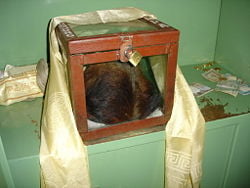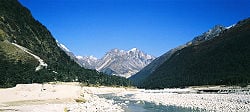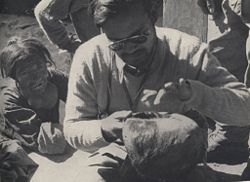Difference between revisions of "Yeti" - New World Encyclopedia
Nick Perez (talk | contribs) |
Nick Perez (talk | contribs) |
||
| Line 14: | Line 14: | ||
==Origins== | ==Origins== | ||
| − | [[Image: | + | [[Image:yumthangnorth.jpg|thumb|250px|right|The Himalayan range at Yumesongdong in [[Sikkim]], in the [[Yumthang]] River valley.]]For centuries, the people who have lived in the Himalayan region of [[Nepal]], [[India]], and [[Tibet]] have believed that the mountains were sacred and mysterious places, due possibly to the fact it is one of the most remote and inaccessible locations on the planet, and remain so to this day. Such a reverrance with nature has historically shown a strong projection of supernatural elements and beliefs into similar regions, and such is the case in the Himalayas where many magical creatures were said to inhabit the mountains, one being the yeti. <ref> "Mysteries of the Unknown: Mysterious Creatures Volume" Time-Life Books, Alexandria: 1988 </ref> Different cultures in the region have held different opinions of the yeti over the years. The Sherpas for example have an almost ambivient feeling towards the creature, often using it as bed time story to help keep children disciplined. The Tibetans, on the other hand, have often viewed the yeti as a creature to be dreaded, as it is seen as ferocious in murual artwork. In Nepal, there are stories of yetis coming down from the mountain to feed off of livestock, occasionally terrorizing the local population directly. It should be noted, that what is often lumped into the idea of the yeti, may actually be many different types of creatures and legends. Interpertations and translations by Westeners over the years have left the origin idea of the yeti somewhat muddled. This is best seen in the creature's name. ''Yeti'' derives from ''yeh-teh'' which refers to an animal that resembles the American sasquatch on a smaller scale, while ''meh-teh'' translates as "man beast", which, from the vantage point of popular perception, is a more fitting description, yet the term yeti has seemingly survived as the popular favorite <ref>"Mysteries of the Unknown: Mysterious Creatures Volume" Time-Life Books, Alexandria: 1988 </ref> |
==The "Abominable Snowman" == | ==The "Abominable Snowman" == | ||
Revision as of 19:01, 5 April 2007

The Yeti is an alleged apelike animal said to inhabit the Himalaya region of Nepal and Tibet. The names Yeti and Meh-Teh are commonly used by the people indigenous to the region,[1] and are part of their history and mythology.
Most mainstream scientists, explorers and writers consider current evidence of the Yeti's existence to be weak and better explained as hoax, legend or misidentification of known species.[2] Nevertheless, the Yeti remains one of the most famous creatures of cryptozoology.
Descripton
The Yeti has often been compared physiologically to the American Sasquatch, as both are large, hold a structural similarity to the great apes family, are covered in hair, have a sagittal crest a top their heads and possess a extremely potent smell. However, unlike sasquatch, there have been fewer visual sightings at close range of the yeti reported in the last century; much of current understanding of the yeti comes from artistic representations in ancient temples and monasteries, as well as stories and legends passed down by the people of the Himalayas. Because of this there are many discrepancies in the region as to what exactly the yeti looks like. Some have suggested that the Yeti is light colored, so as to blend in with the snow and always walk upright, while others have stated that the yeti is smaller, of darker color, walks on four legs like a bear but stands on all two feet when scared or threatend, as gorillas are known to do. Because of the location of the yeti and the romantic adventures associated with expeditions to discover one, the image of the yeti as a monster has not as easily been dropped from popular opinion as has the American sasquatch.
Origins

For centuries, the people who have lived in the Himalayan region of Nepal, India, and Tibet have believed that the mountains were sacred and mysterious places, due possibly to the fact it is one of the most remote and inaccessible locations on the planet, and remain so to this day. Such a reverrance with nature has historically shown a strong projection of supernatural elements and beliefs into similar regions, and such is the case in the Himalayas where many magical creatures were said to inhabit the mountains, one being the yeti. [3] Different cultures in the region have held different opinions of the yeti over the years. The Sherpas for example have an almost ambivient feeling towards the creature, often using it as bed time story to help keep children disciplined. The Tibetans, on the other hand, have often viewed the yeti as a creature to be dreaded, as it is seen as ferocious in murual artwork. In Nepal, there are stories of yetis coming down from the mountain to feed off of livestock, occasionally terrorizing the local population directly. It should be noted, that what is often lumped into the idea of the yeti, may actually be many different types of creatures and legends. Interpertations and translations by Westeners over the years have left the origin idea of the yeti somewhat muddled. This is best seen in the creature's name. Yeti derives from yeh-teh which refers to an animal that resembles the American sasquatch on a smaller scale, while meh-teh translates as "man beast", which, from the vantage point of popular perception, is a more fitting description, yet the term yeti has seemingly survived as the popular favorite [4]
The "Abominable Snowman"
The yeti was first introduced to the western world in 1921, by Henry Newman, a reporter for the Calcutta Statesmen. Writing about a British expedition into the Himalayas, led by Lieutenant Colonel C.K. Howard Bury, Newman noted that the party observed figures moving above them at about 20,000 feet. When the climbing party finally arrived at the spot, they found foot prints much larger than any human could have made. The Sherpas attending the climb told Bury that the prints were made by the creature known as metoh-kangmi, which was actually a mistranslation on the part of Bury, one of many throughout the years that would add to the infamousy of the yeti.Metoh-kangmi is a generic term used in the region for many creatures, but Bury mistook it for the name of the creature. Newman in turn mistranslated Bury's misunderstanding, believing that metch kangmi was Tibetan for abcominable snowman. [5]. Thus, the western world was exposed to a mysterious creature that captured the imagination and attention of many. (Ironically, the intense interest that the adominable snowman story created also helped develop interest in the sasquatch, which was viewed as the American Yeti). For decades after the story, expeditions from around the world would come to the Himalayas, some to climb, for the first time, the world's largest mountain, Mt. Everest, some in search of the snowman.
Expeditions and Evidence
In 1925, N.A. Tombazi, a photographer and member of the Royal Geographical Society, allegedly saw a creature at about 15,000 ft (4572 meter) (near Zemu Glacier. Tombazi later wrote that he observed the creature from about 200 or 300 yards, for about a minute. "Unquestionably, the figure in outline was exactly like a human being, walking upright and stopping occasionally to pull at some dwarf rhododendron bushes. It showed up dark against the snow, and as far as I could make out, wore no clothes." About two hours later, Tombazi and his companions descended the mountain, and saw what they assumed to be the creature's prints, described as "similar in shape to those of a man, but only six to seven inches long by four inches wide.... The prints were undoubtedly those of a biped."
Western interest in the Yeti peaked dramatically in the 1950s. While attempting to scale Mount Everest in 1951, Eric Shipton took photographs of a number of large prints in the snow, at about 6,000 m (19,685 ft) above sea level. These photos have been subject to intense scrutiny and debate. Some argue they are the best evidence of Yeti's existence, while others contend the prints to be from a mundane creature, and have been distorted by the melting snow.
In 1953, Sir Edmund Hillary and Tenzing Norgay reported seeing large footprints while scaling Mount Everest. But Hillary would later discount Yeti reports as unreliable.[6]
During the Daily Mail Snowman Expedition of 1954,[7] the largest search of its kind, the mountaineering leader John Angelo Jackson, made the first trek from Everest to Kangchenjunga during which he photographed symbolic paintings of the Yeti at Thyangboche Gompa.[8] Jackson tracked and photographed many footprints in the snow, most of which were identifiable. However, there were many large footprints which could not be identified. The flattened footprint-like indentations were attributed to erosion and subsequent widening of the original footprint by wind and particles.The Daily Mail "Snowman Expedition" of 1954, on March 19 printed an article which described expedition teams obtaining hair specimens from a scalp found in Pangboche monastery. The hair was analysed by Professor Frederic Wood Jones, F.R.S, D.Sc., (who died on September 29 1954[9][10]) and an expert in human and comparative anatomy.
The research consisted of taking microphotographs of the hairs and comparing them with hairs from known animals such as bears and orangutans. Professor Woods-Jones concluded that the hairs of the Pangboche scalp were not actually from a scalp. He contended that some animals do have a ridge of hair extending from the pate to the back, but no animals have a ridge (as in the Pangboche relic) running from the base of the forehead across the pate and ending at the nape of the neck.
The hairs were black to dark brown in colour in dim light, and fox red in sunlight. None of the hairs had been dyed and were probably exceedingly old. During the study, the hairs were bleached, cut into sections and analysed microscopically. Wood-Jones was unable to pinpoint the animal from which the Pangboche hairs were taken. He was, however, convinced that the hairs were not of a bear or anthropoid ape. He suggested that the hairs were not from the head of a coarse-haired hoofed animal, but from its shoulder.[11]

Beginning in 1957, wealthy American oilman Tom Slick funded a few missions to investigate Yeti reports. In 1959, supposed Yeti feces were collected by Slick's expedition; fecal analysis found a parasite which could not be classified. Bernard Heuvelmans wrote, "Since each animal has its own parasites, this indicated that the host animal is equally an unknown animal." {{Loren Coleman, Tom Slick and the Search for Yeti, Faber & Faber, 1989, ISBN 0-571-12900-5; Loren Coleman, Tom Slick: True Life Encounters in Cryptozoology, Fresno, California: Linden Press, 2002, ISBN 0-941936-74-0 }}
In 1960, Sir Edmund Hillary mounted an expedition to collect and analyse physical evidence of the Yeti. He sent a Yeti "scalp" from the Khumjung monastery to the West for testing, whose results indicated the scalp to be manufactured from the skin of the serow, a goat-like Himalayan antelope. But some disagreed with this analysis. Shackley said that the "hairs from the scalp look distinctly monkey-like, and that it contains parasitic mites of a species different from that recovered from the serow."[citation needed]
In 1970, British mountaineer Don Whillans claims to have witnessed a creature when scaling Annapurna. While scouting for a campsite, Whillans heard some odd cries which his Sherpa guide attributed to a Yeti's call. That very night, Whillans saw a dark shape moving near his camp. The next day, he observed a few human-like footprints in the snow, and that evening, viewed with binoculars a bipedal, apelike creature for 20 minutes as it apparently searched for food not far from his camp. [citation needed]
Debate
Cryptozoologists
After reviewing eyewitness accounts and physical evidence, many cryptozoologists [attribution needed] have concluded that Yeti reports are Enthusiasts speculate that these reported creatures could be present-day specimens of the extinct giant ape Gigantopithecus, as the only evidence recovered from Gigantopithecus (other than teeth) are jawbone remains indicating a skull atop a vertical spinal column (as in hominines and other bipedal apes such as Oreopithecus). However, while the Yeti is generally described as bipedal, most scientists believe Gigantopithicus to be quadrupedal, and so massive that, unless it evolved specifically as a bipedal ape (like Oreopithecus and the hominids), walking upright would have been even more difficult for the now extinct primate than it is for its extant quadrupedal relative, the orangutan.
Skeptics
In popular culture
The Yeti has become a cultural icon, appearing in movies, books and video games. The creature is usually depicted as the scary "Abominable Snowman", but is occasionally used as comic relief. In 2006, Disney opened a ride called "Expedition Everest" in Walt Disney World's Animal Kingdom. Inside the waiting area is a Yeti museum, complete with "Yeti-damaged" items and cement-cast footprints.
ReferencesISBN links support NWE through referral fees
- ↑ Charles Stonor (1955 Daily Mail). The Sherpa and the Snowman. Hollis and Carter.
- ↑ John Napier (2005). Bigfoot: The Yeti and Sasquatch in Myth and Reality. ISBN 0-525-06658-6. .
- ↑ "Mysteries of the Unknown: Mysterious Creatures Volume" Time-Life Books, Alexandria: 1988
- ↑ "Mysteries of the Unknown: Mysterious Creatures Volume" Time-Life Books, Alexandria: 1988
- ↑ Coleman, Loren. "Bogfoot!: The True Story of Apes in America" Paraview Pocket Books, New York: 2003
- ↑ Tenzing Norgay (told to and written by James Ramsey Ullman) (1955). Man of Everest Everest - The Autobiography of Tenzing. George Harrap & Co, Ltd.
- ↑ http://www.cabernet.demon.co.uk/JAJ/snowman1954/1954-snowman-team.html
- ↑ John Angelo Jackson (pp136) (2005). "Chapter 17", Adventure Travels in the Himalaya (pp135-152). ISBN 81-7387-175-2.
- ↑ Jessie Dobson (June, 1956). Obituary: 79, Frederic Wood-Jones, F.R.S.: 1879-1954. Man vol.56: pp. 82-83.
- ↑ Wilfred E. le Gros Clark (Nov., 1955). Frederic Wood-Jones, 1879-1954. Biographical memoirs of Fellows of the Royal Society vol. 1: pp. 118-134.
- ↑ Ralph Izzard (1955). The Abominable Snowman Adventure. Hodder and Staoughton.
- John Napier (primatologist) (MRCS, IRCS, DSC) "Bigfoot: The Yeti and Sasquatch in Myth and Reality" 1972 ISBN 0-525-06658-6.
- Sir Francis Younghusband The Epic of Mount Everest by 1926, Edward Arnold & Co. The expedition that inadvertently coined the term "Abominable Sbowman"
- Charles Howard-Bury, "Mount Everest The Reconnaissance", 1921, Edward Arnold, ISBN 1-135-39935-2.
- H.W. Tilman, "Mount Everest 1938", Appendix B, pp. 127-137, Pilgrim Publishing. ISBN 81-7769-175-9.
- John A. Jackson, More than Mountains, Chapter 10 (pp 92) & 11, "Prelude to the Snowman Expedition & The Snowman Expedition", George Harrap & Co, 1954
- Ralph Izzard, The Abominable Snowman Adventure, this is the detailed account by the Daily Mail correspondent on the 1954 expedition to find the "Snowman", Hodder and Staoughton, 1955.
- Charles Stonor, The Sherpa and the Snowman, recounts the 1955 Dail Mail "Abominable Snowman Expedition" by the scientific officer of the expedition, this is a very detailed analysis of not just the "Snowman" but the flora and fauna of the Himalaya and its people. Hollis and Carter, 1955.
- John A. Jackson, Adventure Travels in the Himalaya Chapter 17, "Everest and the Elusive Snowman", 1954 updated material, Indus Publishing Company, 2005, ISBN 81-7387-175-2.
- Jerome Clark, Unexplained! 347 Strange Sightings, Incredible Occurrences, and Puzzling Physical Phenomena, Visible Ink Press, 1993.
- Bernard Heuvelmans, On the Track of Unknown Animals, Hill and Wang, 1958
- Reinhold Messner, My Quest for the Yeti: Confronting the Himalayas' Deepest Mystery, New York: St. Martin's Press, 2000, ISBN 0-312-20394-2
- Gardner Soule, Trail of the Abominable Snowman, New York: G.P. Putnam's Sons, 1966, ISBN 0-399-6064
See also
- Bigfoot
- Yeren
- Yowie
External links
- Yeh-teh "that thing out there"
- The Unmuseum's Yeti page
- Yeti, The Abominable Snowman - from Occultopedia
- A theory of Yeti (This site is in French)
- The Cryptid Zoo: Yetis
- Migo
Credits
New World Encyclopedia writers and editors rewrote and completed the Wikipedia article in accordance with New World Encyclopedia standards. This article abides by terms of the Creative Commons CC-by-sa 3.0 License (CC-by-sa), which may be used and disseminated with proper attribution. Credit is due under the terms of this license that can reference both the New World Encyclopedia contributors and the selfless volunteer contributors of the Wikimedia Foundation. To cite this article click here for a list of acceptable citing formats.The history of earlier contributions by wikipedians is accessible to researchers here:
The history of this article since it was imported to New World Encyclopedia:
Note: Some restrictions may apply to use of individual images which are separately licensed.